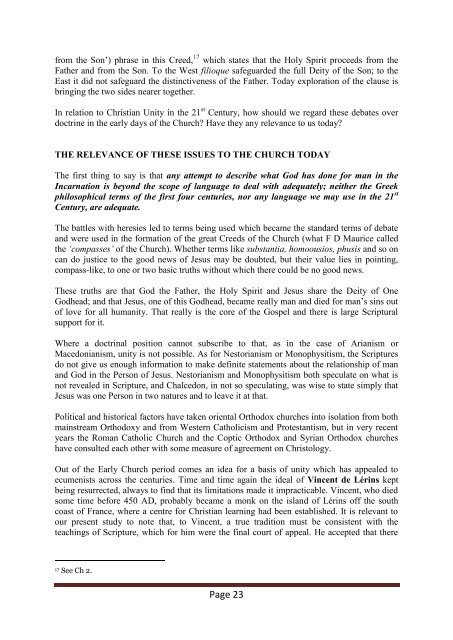Digging Out the Embedded Church - The Maranatha Community
Digging Out the Embedded Church - The Maranatha Community
Digging Out the Embedded Church - The Maranatha Community
You also want an ePaper? Increase the reach of your titles
YUMPU automatically turns print PDFs into web optimized ePapers that Google loves.
from <strong>the</strong> Son‟) phrase in this Creed, 17 which states that <strong>the</strong> Holy Spirit proceeds from <strong>the</strong><br />
Fa<strong>the</strong>r and from <strong>the</strong> Son. To <strong>the</strong> West filioque safeguarded <strong>the</strong> full Deity of <strong>the</strong> Son; to <strong>the</strong><br />
East it did not safeguard <strong>the</strong> distinctiveness of <strong>the</strong> Fa<strong>the</strong>r. Today exploration of <strong>the</strong> clause is<br />
bringing <strong>the</strong> two sides nearer toge<strong>the</strong>r.<br />
In relation to Christian Unity in <strong>the</strong> 21 st Century, how should we regard <strong>the</strong>se debates over<br />
doctrine in <strong>the</strong> early days of <strong>the</strong> <strong>Church</strong>? Have <strong>the</strong>y any relevance to us today?<br />
THE RELEVANCE OF THESE ISSUES TO THE CHURCH TODAY<br />
<strong>The</strong> first thing to say is that any attempt to describe what God has done for man in <strong>the</strong><br />
Incarnation is beyond <strong>the</strong> scope of language to deal with adequately; nei<strong>the</strong>r <strong>the</strong> Greek<br />
philosophical terms of <strong>the</strong> first four centuries, nor any language we may use in <strong>the</strong> 21 st<br />
Century, are adequate.<br />
<strong>The</strong> battles with heresies led to terms being used which became <strong>the</strong> standard terms of debate<br />
and were used in <strong>the</strong> formation of <strong>the</strong> great Creeds of <strong>the</strong> <strong>Church</strong> (what F D Maurice called<br />
<strong>the</strong> „compasses‟ of <strong>the</strong> <strong>Church</strong>). Whe<strong>the</strong>r terms like substantia, homoousios, phusis and so on<br />
can do justice to <strong>the</strong> good news of Jesus may be doubted, but <strong>the</strong>ir value lies in pointing,<br />
compass-like, to one or two basic truths without which <strong>the</strong>re could be no good news.<br />
<strong>The</strong>se truths are that God <strong>the</strong> Fa<strong>the</strong>r, <strong>the</strong> Holy Spirit and Jesus share <strong>the</strong> Deity of One<br />
Godhead; and that Jesus, one of this Godhead, became really man and died for man‟s sins out<br />
of love for all humanity. That really is <strong>the</strong> core of <strong>the</strong> Gospel and <strong>the</strong>re is large Scriptural<br />
support for it.<br />
Where a doctrinal position cannot subscribe to that, as in <strong>the</strong> case of Arianism or<br />
Macedonianism, unity is not possible. As for Nestorianism or Monophysitism, <strong>the</strong> Scriptures<br />
do not give us enough information to make definite statements about <strong>the</strong> relationship of man<br />
and God in <strong>the</strong> Person of Jesus. Nestorianism and Monophysitism both speculate on what is<br />
not revealed in Scripture, and Chalcedon, in not so speculating, was wise to state simply that<br />
Jesus was one Person in two natures and to leave it at that.<br />
Political and historical factors have taken oriental Orthodox churches into isolation from both<br />
mainstream Orthodoxy and from Western Catholicism and Protestantism, but in very recent<br />
years <strong>the</strong> Roman Catholic <strong>Church</strong> and <strong>the</strong> Coptic Orthodox and Syrian Orthodox churches<br />
have consulted each o<strong>the</strong>r with some measure of agreement on Christology.<br />
<strong>Out</strong> of <strong>the</strong> Early <strong>Church</strong> period comes an idea for a basis of unity which has appealed to<br />
ecumenists across <strong>the</strong> centuries. Time and time again <strong>the</strong> ideal of Vincent de Lérins kept<br />
being resurrected, always to find that its limitations made it impracticable. Vincent, who died<br />
some time before 450 AD, probably became a monk on <strong>the</strong> island of Lérins off <strong>the</strong> south<br />
coast of France, where a centre for Christian learning had been established. It is relevant to<br />
our present study to note that, to Vincent, a true tradition must be consistent with <strong>the</strong><br />
teachings of Scripture, which for him were <strong>the</strong> final court of appeal. He accepted that <strong>the</strong>re<br />
17 See Ch 2.<br />
Page 23








